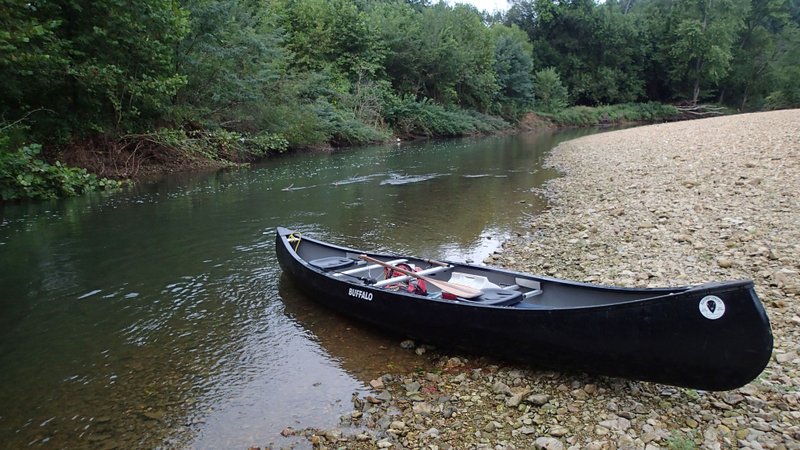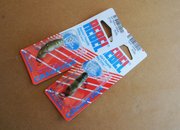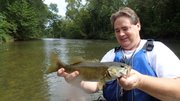The only things missing on the float-fishing trip gone retro were disco music and bell-bottom pants. The hot lure of the day was a big hit in the '70s, but it put just as many fish in the boat as way back when.
Alan Bland and his companion hardly expected a trip down memory lane when they slid a canoe into the War Eagle River on Sept. 25. They had yet to float the War Eagle this year and waited for autumn to make the trip.
War Eagle FAQ
Where is the War Eagle?
The stream comes to life in the Boston Mountains and flows north through Madison and Benton counties. It flows into Beaver Lake downstream of the War Eagle Mill.
How is the paddling?
The War Eagle is an easy Class I stream with pools and riffles. Paddlers may have to portage around fallen trees. A popular canoeing section is a 4.5-mile float from U.S. 412 bridge east of Huntsville to the Arkansas 23 bridge at Withrow Springs State Park.
Is the fishing good?
Smallmouth bass and Ozark bass, also called goggle-eye, are the prized catches for anglers. Sunfish and catfish are plentiful. Small lures and light line of 6-pound test work well on the stream.
What’s the scenery like?
The river bank ranges from forest to pastures. The War Eagle flows past low bluffs, but a couple of bluffs approach 100 feet in height. Paddlers may see deer, mink, herons, eagles and other wildlife.
— Source: Staff report
Their timing was right. The river level and weather were perfect. Trees showed a hint of fall color and wildflowers colored the stream bank. Paddling with Bland is like having a botanist on board. He's a Beaver Lake park ranger with the Army Corps of Engineers and an expert on wildflowers.
"There's some Indian paint brush in bloom," he said. "They're a real pretty late summer flower. "
Yellow woodland sunflowers were in bloom. Spider wort showed bright blue blossoms. Bland pointed out other varieties on the 5-mile float from the Gar Hole low-water bridge to the War Eagle Mill.
The forest and flora were delights above the water. Smallmouth bass prowled below. Bland cast small soft-plastic tube baits hoping to catch a few. The first mile or so produced fair fishing. They caught and released a half-dozen little smallmouths, but the action was slower than most War Eagle float-fishing trips.
A change in tactics by Bland turned the float into a trip down memory lane. He reached deep into his bag of tackle and pulled out a lure he'd not used since "Saturday Night Fever" was a hit movie.
The Rebel Teeny Crawdad miniature crank bait was the go-to lure for stream fishing back in the day. It not only worked on smallmouth bass, but caught every kind of fish in the river.
No doubt lots of anglers have used the Rebel crawdad through the years. Other fishermen somehow gravitated toward jig and pigs, tube baits and other offerings to target big smallmouths. The little crawdad crank bait was somehow forgotten.
Bland caught fish the moment he started using it. Smallmouth bass to 12 inches knocked the fire out of that little bait. Sunfish, too, took a shine to the lure. It was the 1970s all over again.
"I remember using it in high school," Bland said. "You use different baits over the years, but this one is still an effective little dude."
The tiny lure revved up the fishing, but the number of smallmouth bass that bit seemed fewer than on previous War Eagle float trips. A phone call to Jon Stein shed some light. Stein is the region's fisheries biologist with the Arkansas Game and Fish Commission and an a avid angler.
Turns out, black bass numbers, including smallmouth bass, appear to be down in the War Eagle River.
"We've done some pretty extensive electrofishing sampling on the river," Stein said. "We sampled eight sites between Witter and War Eagle Mill. In 2010 and 2011, we were getting 49 black bass per hour of electrofishing. In 2014, that number had dropped to 20."
Floods during spawning time are partly to blame, he said. So is erosion along the river bank.
"In 2011 and 2013 there were some major flooding events in the spring, right at spawning time," Stein explained. "Smallmouths don't spawn well at all in those conditions."
Most of the War Eagle flows through private land in Madison and Benton counties. Erosion occurs during floods on shorelines that have no trees or plants to stabilize the bank. Tons of sediment wash into the War Eagle, which is a major tributary of Beaver Lake. That sediment ends up in the lake, which is the drinking water source for most of Northwest Arkansas.
Game and Fish stream team coordinator Sean Saunders is working with land owners along the War Eagle, Stein said, to get some bank-stabilization work accomplished to combat erosion.
The black bass daily limit on the War Eagle was changed to two fish. Smallmouth must be 14 inches long to keep. Largemouth and spotted bass may be any size.
Flip Putthoff may be reached at [email protected] or on Twitter @NWAFlip
Sports on 10/20/2015




